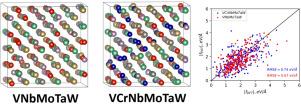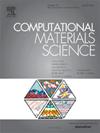N-body interatomic potential for molecular dynamics simulations of V-Cr-Nb-Mo-Ta-W system
IF 3.1
3区 材料科学
Q2 MATERIALS SCIENCE, MULTIDISCIPLINARY
引用次数: 0
Abstract
Diffusion in high-entropy alloys is an important phenomenon controlling its evolution during exploitation. Its detailed investigation, especially at elevated temperatures, is a challenging task. Molecular dynamics simulations facilitate significantly findings in this area and provide valuable insights into it. The key part of the molecular dynamics is the interatomic potential representing the dependence of the potential energy of the system of atoms on their coordinates. To correctly calculate the diffusivity, the potentials should satisfy several criteria such as an accurate reproduction of the melting point and thermal expansion. The last one is crucial as diffusion is strongly influenced by the size factor. We used the N-body approach to construct the interatomic potential for the high-entropy alloy V-Cr-Nb-Mo-Ta-W system, which consists of the potentials for pure elements and binary systems constituting the six-component one. The constituting potentials reproduce structure, elastic, defect and melting properties of pure elements and concentration dependent properties of binary systems. As a test for the VNbMoTaW and VCrNbMoTaW alloys, we calculated the forces acting on atoms for a set of different compositions and obtained the adequate agreement with the density functional theory (DFT) results. Additionally, we computed the surface and excess screw dislocation energies for both pure elements and alloys. The experimental surface energy values averaged over the elements show remarkable agreement (less than 10%) for the equiatomic VNbMoTaW and VCrNbMoTaW alloys. The excess screw dislocation energies of pure elements are predicted in qualitative agreement with DFT results, with tungsten having the highest energy and vanadium and niobium having the lowest. The corresponding values for five- and six-component alloys are less than DFT ones with deviations of 7% and 34%, respectively. They are close or moderately less than the energies averaged over pure elements.

用于 V-Cr-Nb-Mo-Ta-W 体系分子动力学模拟的 N 体原子间势能
高熵合金中的扩散是在开发过程中控制其演变的一个重要现象。对其进行详细研究是一项具有挑战性的任务,尤其是在高温条件下。分子动力学模拟大大促进了这一领域的研究成果,并提供了宝贵的见解。分子动力学的关键部分是原子间势能,它代表了原子系统的势能对其坐标的依赖关系。要正确计算扩散率,原子间势能应满足几个标准,如准确再现熔点和热膨胀。最后一个标准至关重要,因为扩散受尺寸因子的影响很大。我们使用 N-body 方法构建了高熵合金 V-Cr-Nb-Mo-Ta-W 系统的原子间位势,它由纯元素和二元系统的位势组成,构成了六组分位势。构成势再现了纯元素的结构、弹性、缺陷和熔化特性以及二元体系的浓度相关特性。作为对钒铌钽钨合金和钒铬铌钽钨合金的测试,我们计算了一组不同成分的原子作用力,结果与密度泛函理论(DFT)结果完全一致。此外,我们还计算了纯元素和合金的表面能和过量螺旋位错能。对于等原子 VNbMoTaW 和 VCrNbMoTaW 合金而言,元素平均表面能的实验值显示出显著的一致性(小于 10%)。纯元素的过量螺旋位错能量预测与 DFT 结果基本一致,其中钨的能量最高,钒和铌的能量最低。五组份和六组份合金的相应值低于 DFT 值,偏差分别为 7% 和 34%。它们接近或略低于纯元素的平均能量。
本文章由计算机程序翻译,如有差异,请以英文原文为准。
求助全文
约1分钟内获得全文
求助全文
来源期刊

Computational Materials Science
工程技术-材料科学:综合
CiteScore
6.50
自引率
6.10%
发文量
665
审稿时长
26 days
期刊介绍:
The goal of Computational Materials Science is to report on results that provide new or unique insights into, or significantly expand our understanding of, the properties of materials or phenomena associated with their design, synthesis, processing, characterization, and utilization. To be relevant to the journal, the results should be applied or applicable to specific material systems that are discussed within the submission.
 求助内容:
求助内容: 应助结果提醒方式:
应助结果提醒方式:


